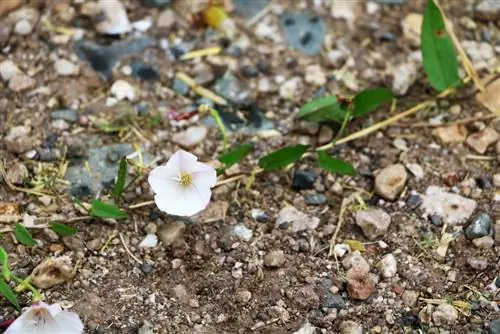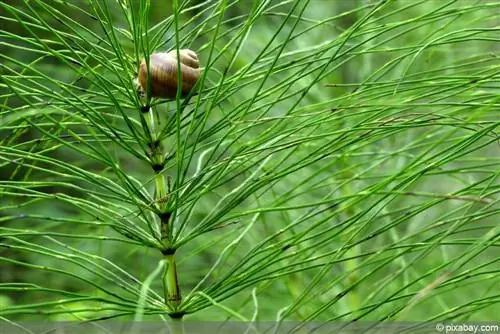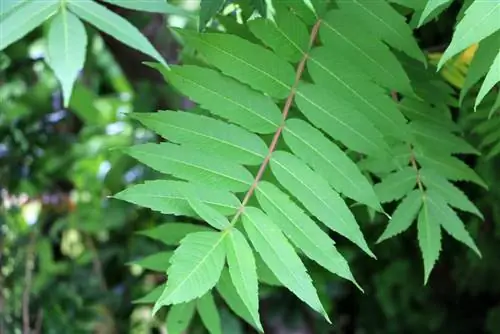- Author admin [email protected].
- Public 2023-12-17 03:39.
- Last modified 2025-01-24 12:45.
Bindweed and bindweed are extremely pretty plants, with delicate and beautifully delicately colored funnel flowers and delicate, rich green, beautifully shaped leaves. They are also easy to grow, they just need to be kept under control. Here are some tips on how to use the beautiful plants sensibly before it comes to combating rampant morning glories:
Why fight and not use?
This is how pretty field bindweed and bindweed can look. If you look a little closer, they become “indicator plants” for how strangely the market works in modern societies: On the one hand, they actually belong in the business administration lecture in the marketing department, because they are such great examples of how a market works of imported products is created by devaluing domestic products that are easily available to everyone across the board. On the other hand, they show convincingly clearly that “ornamental plants” and “weeds” become “ornamental plants” and “weeds” through people - but it is up to you whether you adopt the respective definition of sales-motivated people or determine it yourself.
The whole “phenomenon of logic” or illogic in key words:
- Field bindweed and field bindweed belong to the morning glories family (Convolvulaceae)
- The field bindweed, Convolvulus arvensis, is a species from the genus Convolvulus, from which numerous “siblings” are cultivated and sold as ornamental plants
- Fence morning glories, Calystegia (we have 4 species), are the next genus in the same family, and several species from this genus are also used as ornamental plants
- Morning glories, Ipomoea, are the next genus of the morning glories, of which numerous species are cultivated as ornamental plants
- At least 17 genera from the morning glories family provide additional species that we buy as ornamental plants: Argyreia, Aniseia, Blinkworthia, Cuscuta (silk), Dichondra, Evolvulus, Falkia, Hewittia, Itzaea, Jacquemontia, Merremia, Neuropeltis, Operculina, Rivea, Stictocardia, Turbina, Xenostegia
Results in 20 genera of morning glories, with several to several hundred species that we buy and plant as flowering ornamental plants. A huge amount of morning glories, which we often cultivate with a lot of effort (as annuals) because they don't grow very well in our climate - while we consider our native morning glories, which grow (skillfully limited) completely problem-free and without care, as weeds want to destroy. Field bindweed and bindweed themselves are grown by organic nurseries and also sold as ornamental plants. They are also often used in botanical gardens and plant collections and in naturally managed gardens to decoratively green all sorts of unattractive garden components and edge areas.

Because the morning glories definitely have their place in the ecologically balanced plant society and are useful: Where they grow, many bees, butterflies and beetles come by and value their nectar very much. Bindweed/bindweed do not cause any serious damage, they simply grow surprisingly quickly and sometimes wrap themselves around another plant. As a vigorous native plant, this plant will not necessarily die, the morning glories are more likely to be a stressor on them, making them stronger. The morning glories are part of our native flora and our cultural history; they are no less worthy of preservation than historical buildings. These long-established plant species also form the foundation of our food chain; the 100 most common arable wild herbs (which also include morning glories) provide the habitat for around 1.200 herbivorous beneficial insects, just as many animal species depend on these herbivores, and three quarters of our native field bindweed/bindweed have already become quite rare.
As a home gardener, you can do whatever you want with your garden - but it is up to you to preserve the native flora in all its diversity. You could definitely consider living peacefully with bindweed/bindweed in your garden. The plants with the beautiful flowers can be usefully integrated into the garden and can even save you work as a gardener if you use them cleverly:
Town bindweed and fence bindweed as controlled garden helpers
Both morning glories are wind-fast, and not in a figurative sense, but in fact: a morning glories growing under optimal conditions manages to grow a shoot tip into a 3 cm circle in 1.5 hours, this was measured once. There are ideas on how you can take advantage of this rapid growth, but first of all it's about the prerequisites so that the winds don't outgrow you at some point. The roots of the morning glories grow at a similar rate, even in the surrounding area, where they form a dense, knotted root system. You shouldn't let it get to that point under any circumstances, which is why field bindweed/bindweed should also be cultivated in the garden in a mortar bucket (buried in the ground) or in a bucket (above the ground).
In the pot they can grow as quickly as they want and can be useful in many areas of the garden:
- “Green walls” are trendy, with the local winds you can easily grow them
- On the fence towards the forest or field, in the bucket also on any other fence
- Or on a façade on a cable system upwards
- In and over an old hedge, older beech hedges cope well with the winds
- Any unsightly but useful garden structure becomes “green art” with a winch
- Barrow bindweed grows into green sculptures on a trellis in a pot on the terrace
- They also like to grow up on a privacy wall
- And just as happy to replace the sensitive funnel winch that has already given up
- The morning glories grow along a small fence on the bank of the garden pond
- They are also said to grow in chameleon terrariums and be eaten by the chameleons
- If a field bindweed/bindweed can't find anything to climb up, it crawls along the ground, also pretty
- Some plants give up when they are overgrown by field bindweed, you can use this specifically
- This is how it works B. a weak tree will look pretty for a while at least
- Until it has rotted to the point where it can be easily removed, the winch moves with bucket
- Field bindweed and fence bindweed grow as twiners on tension cords or wire mesh (thread the shoot tips)
- After flowering, the seeds ripen in a few weeks and would then go to seed (usually via animals)
- To prevent this, you can either cut the entire winch down in time
- Or get into the habit of “snapping away wilted flowers as you walk by”
Caution: If fighting morning glories is to become a life issue
You will read a lot of tips on how to effectively combat field bindweed, but you should first think carefully about whether these tips are really effective:
- The best method for combating stubborn morning glories is a fresh bed
- You should simply quickly remove all of the existing soil and replace it with new topsoil
- Sure, but you might also consider moving instead
- Once you have renewed the soil, you should cover this garden area
- With a black, thick film that is hardly pleasing to the eye, the author of this advice at least recognized it
- Subterranean removal is worth a try, but often achieves the opposite effect
- How true, morning glories can sprout from any part of the root
- So you would have to dig a very, very large and deep pit so that you don't increase the problem by cutting up a root
- To avoid this, careful removal by hand is recommended, it remains unclear whether this is your hand or that of a mole
The morning glories could also be controlled with herbicides specially formulated for these plants, is the next tip. However, these do not exist, against winds the general plant protection products are used against "dicotyledonous weeds", which act against all plants that germinate differently than (monocotyledonous) grass etc. The search for plant protection products against field bindweed/barrow bindweed (common fence bindweed; website of Federal Office of Consumer Protection and Food Safety https://apps2.bvl.bund.de/psm/jsp/index.jsp) results in 210 funds. These are almost all plant protection products approved for home and allotment gardens against “dicotyledonous weeds”, with the active ingredients 2, 4-D, clopyralid, dicamba, diflufenican, iron II sulfate, fatty acids (C7-C20), flufenacet, fluroxypyr, Glyphosate, maleic hydrazide, MCPA, mecoprop-P, metosulam and pelargonic acid, so you could use many chemical compounds to combat morning glories.
Of course you can also fight the morning glories with the usual chemical agents from the hardware store or garden center, which is why you can read that, but the use is only recommended if the weed infestation is not next to cultivated plants, otherwise they and the animal and insect world would be unnecessarily affected. The question is whether you should really do that and whether only the animal and insect world will be affected:
- 2, 4-D, dicamba are growth hormones, maleic hydrazide is a growth inhibitor, the effects of both have not been thoroughly researched
- Clopyralid, fatty acids C7 - C20, flufenacet, MCPA, mecoprop-P and pelargonic acid are not only dangerous for plants, but also for people, aquatic organisms, the environment
- Iron II sulfate is “only” dangerous for humans and animals, diflufenican, fluroxypyr, metosulam only for water and the environment, but in 2 out of 3 they have long-term effects
The suspicion that these chemical compounds are also harmful to us humans has been growing for years, here is an article about it: www.rp-online.de/leben/gesundheit/medizin/loesen-pflanzenschutzmittel-entwicklungsstoerungen-aus-aid -1.5411680, and our most common pesticide glyphosate is increasingly being criticized, here is an article on the status of the discussion:
Fight winds without major collateral damage
If the bindweed/bindweed is already there and only bothers you when it winds around uncontrollably - you could let it continue to grow instead of starting the destruction program just described, where it is not certain whether on End winds or gardeners survive.
However, not without measures that “teach the eager plants some discipline”:
- Serious competition for the morning glories are closely sown marigolds or phacelia
- The Mexican marigolds can only be grown as an annual here
- They are therefore more suitable for setting decorative limits to the winds, but are not sustainable on their own
- There are perennial species of Phacelia that can survive reasonably mild winters
- With them it is worth trying to completely eradicate morning glories from a specific location
- Where the morning glories retreat, new Phacelia are planted
- The Phacelia also replace the morning glories ecologically; they are considered to be pasture for bees and green manure plants that improve the soil
- The black-eyed Susan is also said to compete with morning glories
- You can also control the morning glories by simply cutting them off
- Cutting at the top weakens the entire plant, and the roots no longer expand as much
- This allows you to bring winds to reason, but with consistent work you can also destroy them
- You then first have to cut down the entire winch
- And then always cut away every new growth, at some point the weakened plant will give up
- If you or your kids like to do crafts: You should be able to weave very decorative baskets out of the vines
Conclusion
With morning glories it is like with most weeds, if you promote them from “weeds” to “native ornamental plants”, you have only created a wonderfully easy-care and willing-to-grow garden plant through independent thinking. However, sometimes it becomes a little too willing to grow and then it has to be slowed down, and if necessary (because it involves a lot of effort) it can also be fought or destroyed.






